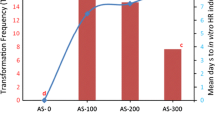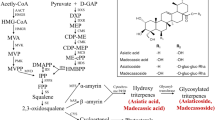Abstract
Hairy root cultures transformed with Agrobacterium rhizogenes or undifferentiated callus cultures are used for production of plant secondary metabolites. Glucosinolates (GS) are a group of secondary metabolites that produce a variety of bioactive compounds upon hydrolysis. Several studies report the successful production of high concentrations of secondary metabolites in vitro. However, such cultivation methods can significantly change metabolic profiles, and the mechanism behind this to be rarely understood. Therefore, we compared the GS and transcript profiles of Arabidopsis thaliana leaves and roots with hairy root and callus in vitro cultures. Compared to the roots of intact A. thaliana plants, overall, hairy roots contained lower GS levels. In particular, lower quantities of short-chain aliphatic GS were observed and a larger proportion of long-chain aliphatic GS on total content. Corresponding, the transcript levels of most aliphatic biosynthetic genes (MAM1, CYP79F1, CYP83A1, UGT74C1, and SUR1) were significantly lower in hairy root cultures compared to roots of intact plants. In callus culture, the lowest transcripts levels were detected for overall GS biosynthetic genes with an absence of aliphatic GS. From the indole group, 1-methoxy-indol-3-ylmethyl GS was found to be a major component in hairy root cultures and roots whereas indol-3-ylmethyl GS dominated in leaves and 4-hydroxy-indol-3-ylmethyl GS in callus cultures. Leaves of intact plants contained the highest amounts of GS. Here, aliphatic short-chain GS dominated which was in accordance with transcript levels of aliphatic biosynthetic genes. The study reveals tissue-specific accumulation of GS and transcript pattern in plants distinct from in vitro culture systems.



Similar content being viewed by others
Abbreviations
- GS:
-
Glucosinolates
- MS medium:
-
Murashige and Skoog medium
- Trp:
-
Tryptophan
References
Alvarez S, He Y, Chen S (2008) Comparative investigations of the glucosinolate-myrosinase system in Arabidopsis suspension cells and hypocotyls. Plant Cell Physiol 49:324–333
Bak S, Tax FE, Feldmann KA, Galbraith DW, Feyereisen R (2001) CYP83B1, a cytochrome P450 at the metabolic branch paint in auxin and indole glucosinolate biosynthesis in Arabidopsis. Plant Cell 13:101–111
Bender J, Fink GR (1998) A Myb homologue, ATR1, activates tryptophan gene expression in Arabidopsis. Proc Natl Acad Sci USA 95:5655–5660
Bones AM (1990) Distribution of beta-thioglucosidase activity in intact plants, cell and tissue-cultures and regenerant plants of Brassica napus L. J Exp Bot 41:737–744
Brown PD, Tokuhisa JG, Reichelt M, Gershenzon J (2003) Variation of glucosinolate accumulation among different organs and developmental stages of Arabidopsis thaliana. Phytochemistry 62:471–481
Bulgakov VP (2008) Functions of rol genes in plant secondary metabolism. Biotech Adv 26:318–324
Cai Z, Kastell A, Knorr D, Smetanska I (2012) Exudation: an expanding technique for continuous production and release of secondary metabolites from plant cell suspension and hairy root cultures. Plant Cell Rep 31:461–477
Chen SX, Petersen BL, Olsen CE, Schulz A, Halkier BA (2001) Long-distance phloem transport of glucosinolates in Arabidopsis. Plant Physiol 127(1):194–201
Chen SX, Glawischnig E, Jorgensen K, Naur P, Jorgensen B, Olsen CE, Hansen CH, Rasmussen H, Pickett JA, Halkier BA (2003) CYP79F1 and CYP79F2 have distinct functions in the biosynthesis of aliphatic glucosinolates in Arabidopsis. Plant J 33:923–937
Davioud E, Kan C, Hamon J, Tempe J, Husson HP (1989) Production of indole alkaloids by in vitro root cultures from Catharanthus trichophyllus. Phytochemistry 28:2675–2680
Fahey JW, Zhang YS, Talalay P (1997) Broccoli sprouts: an exceptionally rich source of inducers of enzymes that protect against chemical carcinogens. Proc Natl Acad Sci USA 94:10367–10372
Fahey JW, Zalcmann AT, Talalay P (2001) The chemical diversity and distribution of glucosinolates and isothiocyanates among plants. Phytochemistry 56:5–51
Fahey JW, Haristoy X, Dolan PM, Kensler TW, Scholtus I, Stephenson KK, Talalay P, Lozniewski A (2002) Sulforaphane inhibits extracellular, intracellular, and antibiotic-resistant strains of Helicobacter pylori and prevents benzo[a]pyrene-induced stomach tumors. Proc Natl Acad Sci USA 99:7610–7615
Fenwick GR, Heaney RK, Mullin WJ (1983) Glucosinolates and their breakdown products in food plants. Crit Rev Food Sci Nutr 18:123–201
Georgiev MI, Pavlov AI, Bley T (2007) Hairy root type plant in vitro systems as sources of bioactive substances. Appl Microbiol Biotechnol 74:1175–1185
Georgiev VG, Weber J, Kneschke EM, Denev PN, Bley T, Pavlov AI (2010) Antioxidant activity and phenolic content of betalain extracts from intact plants and hairy root cultures of the red beetroot Beta vulgaris cv. Detroit dark red. Plant Foods Hum Nutr 65:105–111
Gigolashvili T, Berger B, Mock HP, Müller C, Weisshaar B et al (2007) The transcription factor HIG1/MYB51 regulates indolic glucosinolate biosynthesis in Arabidopsis thaliana. Plant J 50:886–901
Grubb CD, Zipp BJ, Ludwig-Muller J, Masuno MN, Molinski TF, Abel S (2004) Arabidopsis glucosyltransferase UGT74B1 functions in glucosinolate biosynthesis and auxin homeostasis. Plant J 40:893–908
Halkier BA, Gershenzon J (2006) Biology and biochemistry of glucosinolates. Annu Rev Plant Biol 57:303–333
Hirai MY, Sugiyama K, Sawada Y, Tohge T, Obayashi T, Suzuki A, Araki R, Sakurai N, Suzuki H, Aoki K, Goda H, Nishizawa OI, Shibata D, Saito K (2007) Omics-based identification of Arabidopsis Myb transcription factors regulating aliphatic glucosinolate biosynthesis. Proc Natl Acad Sci USA 104:6478–6483
Hoagland DR, Arnon DI (1950) The water-culture method for growing plants without soil. Circ. 347. Univ. of Calif. Agric. Exp. Station, Berkley
Hull AK, Vij R, Celenza JL (2000) Arabidopsis cytochrome P450 s that catalyze the first step of tryptophan-dependent indole-3-acetic acid biosynthesis. Proc Natl Acad Sci USA 97:2379–2384
Jaquinod M, Villiers F, Kieffer-Jaquinod S, Hugouvieu V, Bruley C, Garin J, Bourguignon J (2007) A proteomics dissection of Arabidopsis thaliana vacuoles isolated from cell culture. Mol Cell Proteom 6:394–412
Jeffery EH, Araya M (2009) Physiological effects of broccoli consumption. Phytochem Rev 8:283–298
Kastell A, Smetanska I, Ulrichs C, Cai Z, Mewis I (2013) Effects of phytohormones and jasmonic acid on glucosinolate content in hairy root cultures of Sinapis alba and Brassica rapa. Appl Biochem Biotechnol 169:624–635
Kelly PJ, Bones A, Rossiter JT (1998) Sub-cellular immunolocalization of the glucosinolate sinigrin in seedlings of Brassica juncea. Planta 206:370–377
Kliebenstein DJ (2009) A quantitative genetics and ecological model system: understanding the aliphatic glucosinolate biosynthetic network via QTLs. Phytochem Rev 8:243–254
Koroleva OA, Davies A, Deeken R, Thorpe MR, Tomos AD, Hedrich R (2000) Identification of a new glucosinolate-rich cell type in Arabidopsis flower stalk. Plant Physiol 124:599–608
Maldonado-Mendoza I, Ayora-Talavera T, Loyola-Vargas V (1993) Establishment of hairy root cultures of Datura stramonium: characterization and stability of tropane alkaloid production during long periods of subculturing. Plant Cell Tiss Org Cult 33(3):321–329
Mewis I, Appel HM, Hom A, Raina R, Schultz JC (2005) Major signaling pathways modulate arabidopsis glucosinolate accumulation and response to both phloem-feeding and chewing insects. Plant Physiol 138:1149–1162
Mikkelsen MD, Petersen BL, Glawischnig E, Jensen AB, Andreasson E, Halkier BA (2003) Modulation of CYP79 genes and glucosinolate profiles in Arabidopsis by defense signaling pathways. Plant Physiol 131(1):298–308
Mikkelsen MD, Naur P, Halkier BA (2004) Arabidopsis mutants in the C-S lyase of glucosinolate biosynthesis establish a critical role for indole-3-acetaldoxime in auxin homeostasis. Plant J 37:770–777
Murashige T, Skoog F (1962) A revised medium for rapid growth and bio assays with tobacco tissue cultures. Physiol Plant 15(3):473
Offringa IA, Melchers LS, Regensburg-Tuink AJG, Costantino P, Schilperoort RA, Hooykaas PJJ (1986) Complementation of Agrobacterium tumefaciens tumor-inducing aux mutants by genes from the TR-region of the Ri plasmid of Agrobacterium rhizogenes. Proc Natl Acad Sci USA 83:6935–6939
Petersen BL, Chen SX, Hansen CH, Olsen CE, Halkier BA (2002) Composition and content of glucosinolates in developing Arabidopsis thaliana. Planta 214:562–571
Pfalz M, Mikkelsen MD, Bednarek P, Olsen CE, Halkier BA, Kroymann J (2011) Metabolic engineering in Nicotiana benthamiana reveals key enzyme functions in Arabidopsis indole glucosinolate modification. Plant Cell 23:716–729
Piotrowski M, Schemenewitz A, Lopukhina A, Muller A, Janowitz T, Weiler EW, Oecking C (2004) Desulfoglucosinolate sulfotransferases from Arabidopsis thaliana catalyze the final step in the biosynthesis of the glucosinolate core structure. J Biol Chem 279:50717–50725
Reintanz B, Lehnen M, Reichelt M, Gershenzon J, Kowalczyk M, Sandberg G, Godde M, Uhl R, Palme K (2001) Bus, a bushy Arabidopsis CYP79F1 knockout mutant with abolished synthesis of short-chain aliphatic glucosinolates. Plant Cell 13:351–367
Saw N, Riedel H, Cai ZZ, Kutuk O, Smetanska I (2012) Stimulation of anthocyanin synthesis in grape (Vitis vinifera) cell cultures by pulsed electric fields and ethephon. Plant Cell Tiss Organ Cult 108:47–54
Schreiner M, Krumbein A, Knorr D, Smetanska I (2011) Enhanced glucosinolates in root exudates of Brassica rapa ssp. rapa mediated by salicylic acid and methyl jasmonate. J Agric Food Chem 59:1400–1405
Smetanska I (2008) Production of secondary metabolites using plant cell cultures. Food Biotechnol, vol 111. Springer, Berlin, pp 187–228
Srivastava S, Srivastava AK (2007) Hairy root culture for mass-production of high-value secondary metabolites. Crit Rev Biotechol 27:29–43
Thomashow LS, Reeves S, Thomashow MF (1984) Crown gall oncogenesis: evidence that a T-DNA gene from the Agrobacterium Ti plasmid pTiA6 encodes an enzyme that catalyzes synthesis of indole acetic acid. Proc Natl Acad Sci USA 81:5071–5075
Trejo-Tapia G, Cuevas-Celis J, Salcedo-Morales G, Trejo-Espino HL, Arenas-Ocampo ML, Jimenez-Aparicio A (2007) Beta vulgaris suspension cultures permeabilized with triton x-100 retain cell viability and betacyanines production ability: a digital image analysis study. Biotechnol Prog 23(2):359–363
Verkerk R, Schreiner M, Krumbein A, Ciska E, Holst B, Rowland I, De Schrijver R, Hansen M, Gerhauser C, Mithen R, Dekker M (2009) Glucosinolates in Brassica vegetables: the influence of the food supply chain on intake, bioavailability and human health. Mol Nutr Food Res 53:219–265
Zhang YS, Talalay P, Cho CG, Posner GH (1992) A major inducer of anticarcinogenic protective enzymes from broccoli—isolation and elucidation of structure. Proc Natl Acad Sci USA 89:2399–2403
Zhong JJ (2001) Biochemical engineering of the production of plant-specific secondary metabolites by cell suspension cultures. Advances in Biochemical Engineering/Biotechnology, vol 72. Springer, Berlin, p 26
Zhou ML, Zhu XM, Shao JR, Tang YX, Wu YM (2011) Production and metabolic engineering of bioactive substances in plant hairy root culture. Appl Microbiol Biotechnol 90:1229–1239
Acknowledgments
This work was funded by the German Federal Ministry of Education and Research via Project Management Jülich, Grant No. FKZ: 0315370B. We wish to thank Professor Dietrich Knorr from Berlin University of Technology for supporting this work. We also thank Irene Hemmerich from Berlin University of Technology and Andrea Maikath from Leibniz Institute of Vegetable and Ornamental Crops Großbeeren for the technical assistance. We would like to thank Professor David Tepfer INRA, France for providing the A4 strain.
Author information
Authors and Affiliations
Corresponding author
Electronic supplementary material
Below is the link to the electronic supplementary material.
Rights and permissions
About this article
Cite this article
Kastell, A., Smetanska, I., Schreiner, M. et al. Hairy roots, callus, and mature plants of Arabidopsis thaliana exhibit distinct glucosinolate and gene expression profiles. Plant Cell Tiss Organ Cult 115, 45–54 (2013). https://doi.org/10.1007/s11240-013-0338-7
Received:
Accepted:
Published:
Issue Date:
DOI: https://doi.org/10.1007/s11240-013-0338-7




